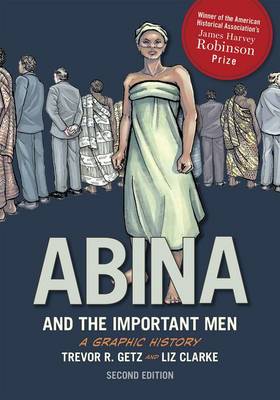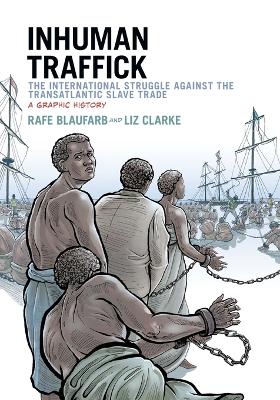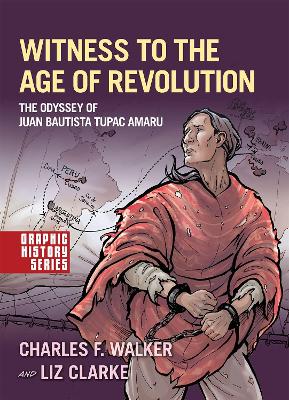Graphic History
4 total works
Winner of the James Harvey Robinson Prize from the American Historical Association, and widely acclaimed by educators and students, Abina and the Important Men, 2e is a compelling and powerfully illustrated "graphic history" based on an 1876 court transcript of a West African woman named Abina, who was wrongfully enslaved and took her case to court. The book is a microhistory that does much more than simply depict an event in the past; it uses the power of
illustration to convey important themes in world history and to reveal the processes by which history is made.
The story of Abina Mansah-a woman "without history" who was wrongfully enslaved, escaped to British-controlled territory, and then took her former master to court-takes place in the complex world of the Gold Coast at the onset of late nineteenth-century colonialism. Slavery becomes a contested ground, as cultural practices collide with an emerging wage economy and British officials turn a blind eye to the presence of underpaid domestic workers in the households of African merchants. The main
scenes of the story take place in the courtroom, where Abina strives to convince a series of "important men"-a British judge, two Euro-African attorneys, a wealthy African country "gentleman," and a jury of local leaders-that her rights matter. "Am I free?" Abina inquires. Throughout both the court
case and the flashbacks that dramatically depict her life in servitude, these men strive to "silence" Abina and to impose their own understandings and meanings upon her. The story seems to conclude with the short-term success of the "important men," as Abina loses her case. But it doesn't end there: Abina is eventually redeemed. Her testimony is uncovered in the dusty archives by Trevor Getz and, through Liz Clarke's illustrations, becomes a graphic history read by people around the world. In
this way, the reader takes an active part in the story along with the illustrator, the author, and Abina herself.
Following the graphic history in Part I, Parts II-V provide detailed historical context for the story, a reading guide that reconstructs and deconstructs the methods used to interpret the story, and strategies for using Abina in various classroom settings.
This edition adds crucial value to Abina's story and the reader's experience. These include:
- new, additional testimony uncovered in the National Archives of Ghana
- a gender-rich section in Part V that explores the Abina's life and narrative as a woman, focusing on such important themes as the relationship between slavery and gender in pre-colonial Akan society, the role of marriage in Abina's experience and motives, colonial paternalism, and the meaning of cloth and beads in her story.
- a forum on the question of whether Abina was a slave with contributions by three senior scholars working from different perspectives: Sandra Greene, Antoinette Burton, and Kwasi Konadu .
illustration to convey important themes in world history and to reveal the processes by which history is made.
The story of Abina Mansah-a woman "without history" who was wrongfully enslaved, escaped to British-controlled territory, and then took her former master to court-takes place in the complex world of the Gold Coast at the onset of late nineteenth-century colonialism. Slavery becomes a contested ground, as cultural practices collide with an emerging wage economy and British officials turn a blind eye to the presence of underpaid domestic workers in the households of African merchants. The main
scenes of the story take place in the courtroom, where Abina strives to convince a series of "important men"-a British judge, two Euro-African attorneys, a wealthy African country "gentleman," and a jury of local leaders-that her rights matter. "Am I free?" Abina inquires. Throughout both the court
case and the flashbacks that dramatically depict her life in servitude, these men strive to "silence" Abina and to impose their own understandings and meanings upon her. The story seems to conclude with the short-term success of the "important men," as Abina loses her case. But it doesn't end there: Abina is eventually redeemed. Her testimony is uncovered in the dusty archives by Trevor Getz and, through Liz Clarke's illustrations, becomes a graphic history read by people around the world. In
this way, the reader takes an active part in the story along with the illustrator, the author, and Abina herself.
Following the graphic history in Part I, Parts II-V provide detailed historical context for the story, a reading guide that reconstructs and deconstructs the methods used to interpret the story, and strategies for using Abina in various classroom settings.
This edition adds crucial value to Abina's story and the reader's experience. These include:
- new, additional testimony uncovered in the National Archives of Ghana
- a gender-rich section in Part V that explores the Abina's life and narrative as a woman, focusing on such important themes as the relationship between slavery and gender in pre-colonial Akan society, the role of marriage in Abina's experience and motives, colonial paternalism, and the meaning of cloth and beads in her story.
- a forum on the question of whether Abina was a slave with contributions by three senior scholars working from different perspectives: Sandra Greene, Antoinette Burton, and Kwasi Konadu .
The dramatic story of the slave ship Neirsee springs vividly to life in Rafe Blaufarb's graphic mircohistory, Inhuman Traffic. The story, set in the early nineteenth century, moves from the slave port of Old Calabar to the Caribbean and to the courts of Britain and France where the history of the illegal slave trade, slavery in the Caribbean, and diplomatic history all come into focus as Blaufarb follows the ship, its crew, and its captives. Students will be taken in
by the vivid drawings and the rich narrative, but they will also find themselves immersed in an unusual learning experience. Blaufarb not only presents the history of the ship and captives, he takes the reader inside the project itself. He explains how he came upon the story, how he and his editor
envisioned the project, and how he worked with the illustrator Liz Clarke to craft the 350 "cells" that compose the book. He and Clarke even take the reader inside archives in Britain and France which are themselves illustrated and their histories explained. Like all the best examples of the genre, Inhuman Traffic tells a compelling story through a complex interplay of image and text — it will keep students reading, and learning, to the very end.
by the vivid drawings and the rich narrative, but they will also find themselves immersed in an unusual learning experience. Blaufarb not only presents the history of the ship and captives, he takes the reader inside the project itself. He explains how he came upon the story, how he and his editor
envisioned the project, and how he worked with the illustrator Liz Clarke to craft the 350 "cells" that compose the book. He and Clarke even take the reader inside archives in Britain and France which are themselves illustrated and their histories explained. Like all the best examples of the genre, Inhuman Traffic tells a compelling story through a complex interplay of image and text — it will keep students reading, and learning, to the very end.
The Tupac Amaru rebellion of 1780-1783 began as a local revolt against colonial authorities and grew into the largest rebellion in the history of Spain's American empire-more widespread and deadlier than the American Revolution. An official collector of tribute for the imperial crown, Jose Gabriel Condorcanqui had seen firsthand what oppressive Spanish rule meant for Peru's Indian population and, under the Inca royal name Tupac Amaru, he set events in motion
that would transform him into one of Latin America's most iconic revolutionary figures. While he and the rebellion's leaders were put to death, his half-brother, Juan Bautista Tupac Amaru, survived but paid a high price for his participation in the uprising.
This work in the Graphic History series is based on the memoir written by Juan Bautista about his odyssey as a prisoner of Spain. He endured forty years in jails, dungeons, and presidios on both sides of the Atlantic. Juan Bautista spent two years in jail in Cusco, was freed, rearrested, and then marched 700 miles in chains over the Andes to Lima. He spent two years aboard a ship travelling around Cape Horn to Spain. Subsequently, he endured over thirty years imprisoned in Ceuta, Spain's
much-feared garrison city on the northern tip of Africa. In 1822, priest Marcos Duran Martel and Maltese-Argentine naval hero Juan Bautista Azopardo arranged to have him freed and sent to the newly independent Argentina, where he became a symbol of Argentina's short-lived romance with the Incan Empire.
There he penned his memoirs, but died without fulfilling his dream of returning to Peru.
This stunning graphic history relates the life and legacy of Juan Bautista Tupac Amaru, enhanced by a selection of primary sources, and chronicles the harrowing and extraordinary life of a firsthand witness to the Age of Revolution.
.
that would transform him into one of Latin America's most iconic revolutionary figures. While he and the rebellion's leaders were put to death, his half-brother, Juan Bautista Tupac Amaru, survived but paid a high price for his participation in the uprising.
This work in the Graphic History series is based on the memoir written by Juan Bautista about his odyssey as a prisoner of Spain. He endured forty years in jails, dungeons, and presidios on both sides of the Atlantic. Juan Bautista spent two years in jail in Cusco, was freed, rearrested, and then marched 700 miles in chains over the Andes to Lima. He spent two years aboard a ship travelling around Cape Horn to Spain. Subsequently, he endured over thirty years imprisoned in Ceuta, Spain's
much-feared garrison city on the northern tip of Africa. In 1822, priest Marcos Duran Martel and Maltese-Argentine naval hero Juan Bautista Azopardo arranged to have him freed and sent to the newly independent Argentina, where he became a symbol of Argentina's short-lived romance with the Incan Empire.
There he penned his memoirs, but died without fulfilling his dream of returning to Peru.
This stunning graphic history relates the life and legacy of Juan Bautista Tupac Amaru, enhanced by a selection of primary sources, and chronicles the harrowing and extraordinary life of a firsthand witness to the Age of Revolution.
.
Inspired by the resounding success of Abina and the Important Men (OUP, 2011), Mendoza the Jew combines a graphic history with primary documentation and contextual information to explore issues of nationalism, identity, culture, and historical methodology through the life story of Daniel Mendoza. Mendoza was a poor Sephardic Jew from East London who became the boxing champion of Britain in 1789. As a Jew with limited means and a foreign-sounding
name, Mendoza was an unlikely symbol of what many Britons considered to be their very own "national" sport. Whereas their adversaries across the Channel reputedly settled private quarrels by dueling with swords or pistols—leaving widows and orphans in their wake—the British (according to supporters of boxing) tended to
settle their disputes with their fists.
Mendoza the Jew provides an exciting and lively alternative to conventional lessons on nationalism. Rather than studying learned treatises and political speeches, students can read a graphic history about an eighteenth-century British boxer that demonstrates how ideas and emotions regarding the "nation" permeated the practices of everyday life. Mendoza's story reveals the ambivalent attitudes of British society towards its minorities, who were allowed (sometimes grudgingly) to
participate in national life by braving pain and injury in athletic contests, but whose social mobility was limited and precarious.
name, Mendoza was an unlikely symbol of what many Britons considered to be their very own "national" sport. Whereas their adversaries across the Channel reputedly settled private quarrels by dueling with swords or pistols—leaving widows and orphans in their wake—the British (according to supporters of boxing) tended to
settle their disputes with their fists.
Mendoza the Jew provides an exciting and lively alternative to conventional lessons on nationalism. Rather than studying learned treatises and political speeches, students can read a graphic history about an eighteenth-century British boxer that demonstrates how ideas and emotions regarding the "nation" permeated the practices of everyday life. Mendoza's story reveals the ambivalent attitudes of British society towards its minorities, who were allowed (sometimes grudgingly) to
participate in national life by braving pain and injury in athletic contests, but whose social mobility was limited and precarious.



